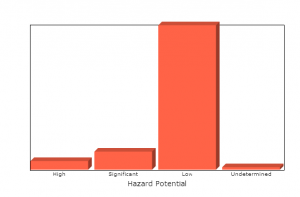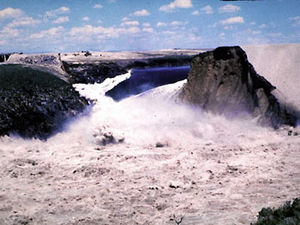
In the wake of massive flooding, dam failures and destruction in Colorado, the construction and maintenance of dams has never been more vividly underscored.
Most property owners are unaware of potential hazards downstream of dam structure providing everything from flood protection, power generation to recreation. Many of the uses are combined and result in 365 day 24/7 benefit.
The proposed Fargo Dam and FM Diversion is unique, in the capacity that it’s proposed primary benefit is to provide a level of protection during brief spring melt and run-off as a result of winter snowfall accumulations.
The proposed project does not protect the Fargo area from heavy rain events that can and have occurred within the 261 square mile footprint.
According to the www.damsafety.org, there are 1208 dams as of 2012 in North Dakota.
- 44 are listed as High Hazard Potential
- 89 are listed as Significant Hazard Potential
- 1075 are listed as Low Hazard Potential
The NID (National Inventory of Dams) categorizes dams as those meeting at least one of the following criteria;
- High hazard classification – loss of one human life is likely if the dam fails,
- Significant hazard classification – possible loss of human life and likely significant property or environmental destruction,
- Equal or exceed 25 feet in height and exceed 15 acre-feet in storage,
- Equal or exceed 50 acre-feet storage and exceed 6 feet in height.
The proposed Fargo Dam and FM Diversion exceeds all of the criteria outlining Class 1 High Hazard dams, yet the Fargo Diversion Authority, Cass county and U.S. Corps of Engineers methodically massaged terminology during the EIS process to limit public reaction to the chosen public relations message.
North Dakota ranks 37 of 50 with a State Total Budget of $275,720 to oversee North Dakotas inventory of dams. Will the proposed 12.5 mile wide Class 1 High Hazard dam south of Fargo receive necessary attention to ensure that proper inspection and maintenance will be conducted?
According to the 2013 Report Card for America’s Infrastructure the U.S. Army Corps of Engineers estimates that more than $21 billion will be required to address dam deficiencies for Corps-owned dams. That $21 billion does not include dams turned over to local sponsors.
What will become of the proposed $2 billion plus Fargo Dam and FM Diversion if and when it’s completed and turned over to the local sponsor? How will the local sponsor (Fargo), shoulder mounting costs of ground shift, changes in material cohesion causing internal and external degradation or the onslaught of burrowing animals?
Even more disconcerting is the average age of 84,000 dams in the country is around 52 years of age.
2,000 of the dams are listed as deficient high-hazard dams.
We can marvel and boast at mans engineering achievements, however, the stark reality is that these achievements are nothing more than future financial liabilities that dwarf much of the purported benefit, morphing into potential silent killers as they fall into disrepair.
Currently, there is core drilling being conducted in and around the Oxbow, ND area to determine if the soil is stable enough to hold a proposed ring-dike. The sole purpose of the proposed ring-dike is to facilitate the creation of a temporary man-made lake around the communities of Bakke, Hickson and Oxbow, ND during times of flooding. A high risk venture that has never been done before with no assessment from FEMA to determine potential flood premiums or insure-ability.
History tends to repeat itself…
Annual reports preceding the 1927 Mississippi flood reflect the Corps had confidently told Congress that the Mississippi was safe from serious flooding. Yet, the Mississippi river and many of its tributaries defied USACE confident claims of security. Cited Source: CATO Institute

In July of 1961 core drilling commenced to determine if the then proposed Grand Teton dam would be viable. In March 1962, the Corps of Engineers recommended construction of the Teton Project, including the Teton Dam. Cited Source: U.S. Bureau of Reclamation Narrative
The U.S. Corps of Engineers “recommended” Grand Teton dam was completed in November 1975.
The very same U.S. Corps of Engineers “recommended dam” failed on Saturday, June 5, 1976 a mere 6 months after completion due to permeable soil and water seepage.
On April 12th, 2013 – U.S. District Judge Stanwood Duval lambasted the Army Corps of Engineers for engineering decisions he says were responsible for Katrina levee and flood-wall failures, as well as the legal process that has granted the corps immunity from paying for the billions of dollars in damages caused by the flooding.
“I feel obligated to note that the bureaucratic behemoth that is the Army Corps of Engineers is virtually unaccountable to the citizens it protects..” Cited Source: www.nola.com
The U.S. Corps of Engineer has made several “recommendations” regarding the alignment, placement and capacity of the proposed Fargo Dam and FM Diversion, yet they unmovable components keep moving and the flow capacity of the diversion component has dropped by over 42.5 percent and the staggering price tag remained the same.
It does make one start to question the misplaced value of “recommendations” from the U.S. Army Corps of Engineers.
Here is the Music Player. You need to installl flash player to show this cool thing!
Despite the feigned reassurances of Keith Berndt on August 12th, 2013 during the MNDak Upstream Coalition/Richland Wilkin JPA meeting, the ensuing laughter indicates there is little comfort that one of the largest earth moving projects in North America, second to the Panama canal, will be a “safe and secure” structure. It is perilous to believe the project will come in on time and on budget when advance anticipated maintenance costs already exceed $3.6 million annually.
There is a fine line between confidence and arrogance…,
one that Keith Berndt and the USACE repeatedly cross.
From Jan. 1, 2005 through June 2013, state dam safety programs reported 173 dam failures and 587 “incidents” – episodes that, without intervention, would likely have resulted in dam failure. Cited Source: Association of State Dam Safety Officials – US Failure Incidents
Does it make sense to spend $2 billion plus, to spend another $3.6 million annually in maintenance when average flood fighting costs do not exceed the anticipated maintenance? The United States levees and dams have a lengthy history of being built.., turned over to local control, then neglected to conditions of imminent failure.
The most responsible course of action would be to complete dikes, levees and floodwalls internally within Fargo. Then “closely” monitor those structures and any encroachment into the natural flood plain that would diminish the efficacy of those flood mitigation efforts.
If flood protection is truly to end goal then protecting the city that currently exists, rather than obligating Minnesota to keep up with Fargo expansion and gambling hundreds of millions of taxpayer dollars to placate local development interests obsession with the last natural flood plain adjacent to the Fargo area, would be a more genuine course of action.
Views: 345
